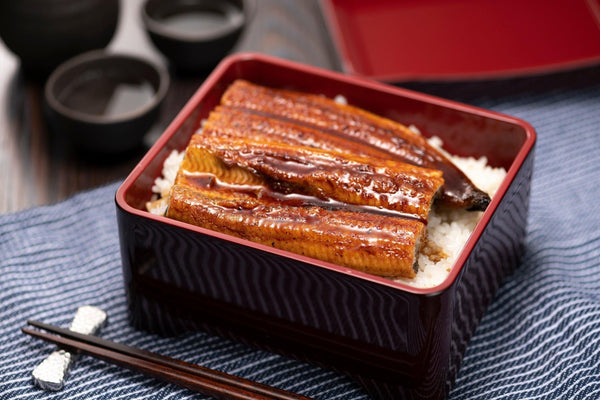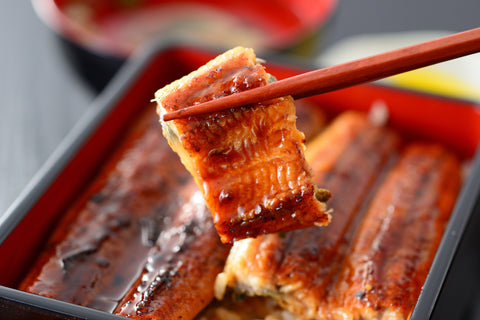
Jump to:
Of the many “unique” or “exotic” foods that are associated with Japanese cuisine, few if any stand out more than unagi.
Freshwater eel, commonly known as “unagi” in Japanese (and not to be confused with the similar sounding and looking “anago” saltwater eel), has been a long-standing favorite in this island nation for centuries.
Though it might not be the most pleasant creature to be face-to-face with – and thus can be off-putting for many visitors to Japan or newbies in a Japanese restaurant abroad – unagi has a special place in the culinary culture of Japan. Prized for its delicate flavor and rich texture, unagi is a popular dish and a coveted “treat” in Japanese cuisine. It is often grilled or broiled and served with a sweet and savory sauce known as “tare”.
Let’s dive into the world of unagi, exploring its origins, preparations, benefits and alternatives. Feeling skittish about the prospects of unagi? We encourage you to read on and discover why it’s coveted.
Background, Fun Facts & Food Briefing: An Unagi Primer

Freshwater eel or “unagi” is a traditional dish and mainstay in Japanese cuisine. While not considered an “everyday” kind of food due to its price and availability, unagi is often eaten during the summer months – and yet it can be found on the menu year-round.
Unagi is said to offer a wide range of health benefits. It is thought to help boost energy levels and stamina and is also considered a good source of protein and omega-3 fatty acids. The aforementioned “summer food” nature of unagi stems from the notion that it helps combat heat exhaustion and fatigue, which are all too common in Japan’s hot, humid summer months that seem to slow everyone down.
Unagi first found popularity in Japan’s food scene some 300-400 years ago. While much of Japan’s diet has traditionally centered around seafood – which makes sense for an archipelago nation – unagi is harvested in rivers and lakes, as well as in estuaries. Its origins are of salt water, and the sea, but unagi is considered a freshwater eel.
The Flavor Of Unagi
If you’re not familiar with the taste of unagi, you might be thinking (or have been told?) that it’s one of those exotic foods that “tastes like chicken.”
But no, not really, not in our opinion anyhow. As eel is a fish (though it looks much like a snake, which is said to taste like rubbery chicken), unagi has more in common taste-wise with fish or seafood than it does with the ubiquitous chicken.
Unagi has a delicate flavor that is often described as sweet and savory. The flavor of unagi can vary depending on how it is prepared. Grilled or broiled unagi has a richer flavor than poached or steamed unagi.
How Unagi Is Prepared

There are many different ways to prepare unagi in Japanese cuisine. Each has its uses and purposes, and preferences vary widely as to the “best” way to eat unagi.
One popular unagi cooking method is to grill or broil the eel and then brush it with a sweet and savory sauce called “tare.” This dish is called kabayaki. Unagi kabayaki is often served over rice, or plated with rice as part of the meal in a separate vessel. If you’ve ever walked by an unagi restaurant, let alone dined in one, you’ll know the distinct and captivating aroma of grilled unagi – fueled by the tare (unagi sauce) hitting the coals and caramelizing for an olfactory delight.
A variation on unagi kabayaki is shirayaki, which is the same method sans the sauce (no “tare”). Some people lean towards shirayaki as they say it allows the true taste of the eel to shine.
Another popular way to prepare unagi in Japanese cuisine is to eat it as sushi. Unagi sushi is made by grilling or broiling the eel and then slicing it thinly. It is then served with rice and other toppings, such as cucumber, avocado, and tobiko. Unagi is never served raw, either as sushi or sashimi. Why not?
Raw eel is poisonous. Cooking eel, such as unagi, breaks down the toxins and makes it safe (and delicious!) to eat. Do not attempt to prepare raw eel at home – be sure to cook it well and all the way through.
How To Cook Unagi

There are many different ways to cook unagi. Here are a few popular methods:
Grilled Unagi
Grilling over coals is the most common method for cooking unagi. To grill unagi, preheat your grill to a medium heat level. Brush the eel with “tare” (a sweet and savory sauce) and then grill it for 3-4 minutes per side, or until it is thoroughly cooked. Add tare to taste, if necessary.
Broiled Unagi
Broiling in an oven (even a toaster oven!) is another popular method for cooking unagi. To broil unagi, preheat the broiler to high heat. Top the eel with tare, wrap it in foil, and broil it for approx. 3-4 minutes per side or until cooked all the way through.
Poached Unagi
Poaching is a gentler method for cooking unagi that preserves its delicate flavor. To poach unagi, bring a pot of water to a simmer. Add the eel to the pot and poach it for 5-7 minutes, or until it is cooked completely. Add tare as desired.
Steamed Unagi
Steaming is another gentle method for cooking unagi that allows the delicate flavor to be the star. To steam unagi, place the eel in a steamer basket and steam it for 5-7 minutes, or until it is cooked thoroughly. You might want tare here, or you might not – try both and see what you like best.
Unagi Sauce: What “Tare” Is & How To Make It

“Unagi no tare” (or unagi sauce) is a sweet and savory sauce that is used especially for the preparation and serving of freshwater eel. It is made with soy sauce, mirin, sugar, and sake (Japanese rice wine).
Don’t have unagi sauce for sale near you? Not a problem – you can make it at home!
You’ll only need a few ingredients, and the heavy hitters can be purchased right here on this website (we’ve linked the products below for your convenience).
Soy Sauce
Known in Japan as “shoyu,” soy sauce is perhaps the most commonly known Japanese sauce (and one of the most popular ingredients) in the US and around the world. Found in a variety of foods as both an ingredient and/or a condiment, soy sauce runs a full range from basic to high-end craft shoyu.
Japanese Sake
Sake, or Japanese rice wine, is great for drinking on its own – the image of sake is often that it would be served as “hot sake,” but the better sake are in fact served chilled). Much like its western wine counterparts, sake is also used widely for cooking in Japan.
Mirin
Mirin is a type of rice wine, though unlike sake it has a very low alcohol content. Higher in sugar, mirin is much of what delivers the sweetness in an unagi sauce (tare).
Sugar
Sugar adds more sweetness to the tare, of course, but also thickness. The sugar at your local grocery store will do well here.
Unagi no Tare – How to Prepare The Sauce
The ratio for tare is “3-1-3.”
- 3 parts mirin
- 1 part sake
- 3 parts soy sauce
… for starters, you can go with 60mL (¼ cup) of mirin & soy sauce, with 1.5 tablespoons of sake. Then add sugar gradually, starting with 1.5 tbsp (equal to the sake portion) and adjusting to taste. Depending on the cooking method, you may want higher or lower amounts of sugar (grilling or broiling, for example, will really get the unagi caramelized).
If you have leftover tare, you can also use it for making Japanese favorites such as “yaki onigiri” (grilled rice balls). Be sure to refrigerate the batch.
Other Foods That Pair Well With Unagi
Unagi can be paired with a variety of other dishes and products. Some popular pairings include the following.
Unagi on or with Rice

Unagi is often served with rice. This helps to soak up the sweet and savory sauce. Unagi can be served over a bed of rice in a traditional lacquer box – that’s generally the preparation for unagi kabayaki. It can also be served in a rice bowl, known as “unagi-don” or “unadon” for short. A twist on the rice is to serve it on the side, in a separate bowl for example, and have the unagi plated on its own to shine as the star.
Unagi Sushi

Unagi is a popular ingredient in sushi. It can be served as nigiri (sliced unagi on vinegared rice), or in sushi rolls (cut into smaller pieces or as a “temaki” hand roll). It can be paired with other ingredients, such as avocado, cucumber, and tobiko.
Unagi as Part of a Set

It’s not uncommon to see unagi featured in a set meal in restaurants. Other standouts to pair unagi with include sashimi, tempura, and of course the standard accompaniments such as miso soup and salad.
Another favorite to pair with the unagi meat is the unagi liver or “kimo” (pictured, from the Nishiki Market in Kyoto). Served over rice, this unagi duo is a rich, complex experience that you’re not likely to forget anytime soon.
Sustainability Of Unagi
We’d be remiss if we didn’t address the sustainability of unagi, which admittedly is a rather complex issue.
Concerns exist about the environmental impact of unagi farming, as well as the welfare of the eels themselves. Many Japanese people, however, believe that eating unagi can be sustainable if it is done responsibly. They argue that there are ways to farm unagi that are less harmful to the environment and that eels can be raised in a humane way.
Ultimately, the decision of whether or not to eat unagi is a personal one. Consumers should be aware of the sustainability concerns surrounding unagi and make an informed decision based on their own values.
Cost Of Unagi
Unagi is a relatively expensive dish. This is due to simple supply and demand factors, as well as the labor intensiveness involved in both the front and back end of the unagi cycle.
The cost of unagi can vary depending on the region, the quality of the eel, and the method of preparation. In general, unagi is more expensive than other types of fish.
Where To Buy Unagi

Unagi is available at many Japanese restaurants and specialty food stores. It can also be purchased online. When buying unagi, it is important to choose a reputable source.
Here are a few tips for buying unagi:
- Look for unagi that is fresh and has a good color – the eel should be firm and pink in color (frozen unagi is acceptable if fresh is not available, so long as it is packaged and sold by good suppliers/retailers)
- Avoid unagi that is pale or has a strong odor
- Ask the store where the unagi was sourced; if the store cannot provide you with this information, probably best to give it a pass
Unagi Alternatives
If you are looking for an unagi alternative, for cost reasons or for vegetarian/vegan preferences, there are options available. Some popular unagi alternatives include:
Anago (conger eel)

Not to be confused with unagi, anago (or conger eel) is a type of saltwater eel that has a similar flavor to unagi. It can be grilled or broiled and served with tare.
Eggplant as Unagi-Esque

Eggplant can be prepared in a variety of ways to mimic the flavor and texture of unagi. One popular method is to grill or roast the eggplant and then brush it with tare – serving it, essentially, as a swap-out/swap-in for unagi.
Experience The History & Delicacy Of Unagi
Unagi is a delicious and versatile dish that has a long history in Japanese cuisine.
There are many different ways to enjoy unagi, and it can be paired with a variety of other ingredients and dishes. A number of unagi alternatives are also available, which can be a good choice for those who are looking for a more sustainable or affordable option.
If you’ve yet to try unagi, we encourage you to give it a go – either at a restaurant or by trying your hand at cooking unagi.
If you’re an unagi lover (as we are), we’d love to hear how your unagi home cooking endeavors turn out!


0 comments